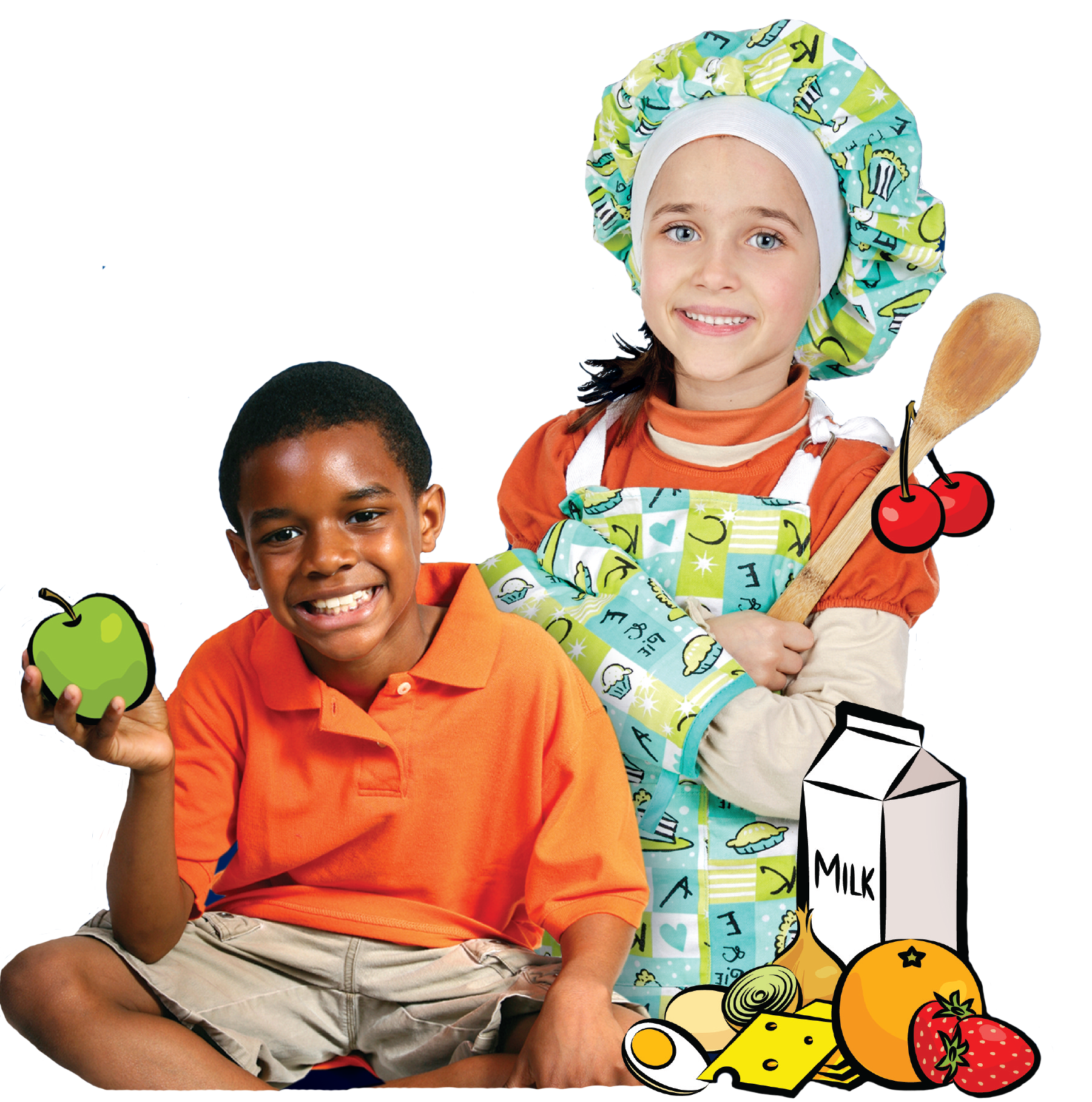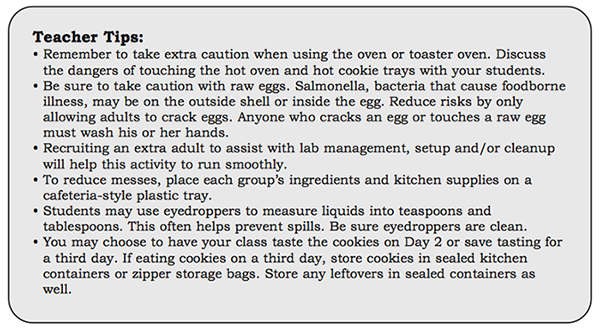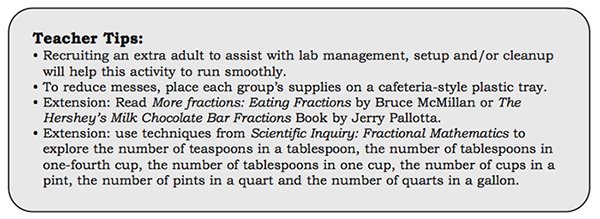 Relevancy and Engagement
oklahoma.agclassroom.org
Relevancy and Engagement
oklahoma.agclassroom.org
FoodMASTER: Measurement
Grade Level
Purpose
Students discover where the ingredients in a cookie are made and make chocolate chip oatmeal cookies to practice their measurement skills and fractional mathematics. Grades 3-5
Estimated Time
Materials Needed
Activity 1: Cups, Spoons, and Scales
- For the teacher: 1 set dry measuring cups, 1 spoon, 1 table knife, 1 set measuring spoons, small to medium size bowl, flour, brown sugar.
- For each group: 1 set dry measuring cups, 1 kitchen scale, 1 small bowl (or medium bowl), 2 spoons, 1 table knife (for leveling), 3 gallon-size re-sealable zipper storage bags (labeled 1, 2 & 3), 1 set measuring spoons, 1 cup flour, 1 teaspoon baking powder, 1/2 teaspoon baking soda, 1/2 teaspoon salt, 1 cup chocolate chips (1/2 of a 12-ounce package), 3/4 cup oats, 3/4 cup packed brown sugar. Optional: Plastic trays (to hold ingredients).
- Measuring Up student handout
- Cups, Spoons, and Scales student handout
- Teacher Answer Key
Activity 2: Liquid Measurement
- For the teacher: Oven or toaster oven, 1 liquid measuring cup, 1 small pitcher of water, 1 set measuring spoons, cookie trays, 1 set oven mitts, 1 spatula, wire cooling racks or foil sheets, extra zipper storage bags to store cookies.
- For each group: 1 medium bowl (or large bowl), 1 set measuring spoons, 1 stirring spoon, 2 small spoons, 1 cookie sheet, 1 egg, 1/2 cup butter (softened), 1 1/2 teaspoons water, 1/4 teaspoon vanilla extract, storage bags 1, 2, & 3 from Day 1: Cups, Spoons and Scales. Optional: eye droppers (to measure liquid ingredients).
- Liquid Measurement student handout
- While You Wait: Fractional Mathematics: 1 set dry measuring cups, 1 liquid measuring cup, 1 plastic tray, 2 cups of water (in a small pitcher or container) for each group.
- Fractional Mathematics student handout
- Teacher Answer Key
Elaborate
Essential Files
Vocabulary
dry ingredients: dry foods or spices used in cooking and baking
liquid ingredients: liquid foods or spices used in cooking and baking
packed: the ingredient is pushed or pressed into a measuring cup
Background Agricultural Connections
Introduction to FoodMASTER:
FoodMASTER (Food, Mathematics and Science Teaching Enhancement Resource) is a compilation of programs aimed at using food as a tool to teach mathematics and science. It is our theory that if food is used as a tool to teach mathematics and science, students will be better prepared to demonstrate and apply mathematic and scientific knowledge. Because students encounter food on a daily basis, they have preexisting contextual experiences preparing them for learning new and relevant mathematics and science material.
Food is conducive to hands-on and virtual, inquiry-based, active learning that uses multiple senses to engage students in the learning process. Utilizing food allows for an interdisciplinary approach to learning concepts and ideas in a variety of scientific subjects like general science, biology, chemistry, microbiology, nutrition and health. Additionally, food labs are a dynamic way to teach mathematics concepts such as numbers and operations, algebra, geometry, measurement and problem solving.
The knowledge and skill development that can be inspired by the FoodMASTER approach is limitless. Proper use of measurement tools, data collection and interpretation, application and generalization, classification and organization, graphing and comparative analysis, understanding chemical changes, observing functions of ingredients and controlling variables, pricing, critical thinking, self-directing learning, and team building are only a few of the potential knowledge and skill development areas for intermediate grade students experiencing FoodMASTER’s scientific inquiry labs.
Additional FoodMASTER lessons can be found to cover health and nutrition topics such as:
- Food Safety
- Vegetables
- Fruits
- Meat, Poultry, and Fish
- Eggs
- Fats and Oils
- Grains
- Measurement
- Meal Management
Background for this Lesson:
Fractional mathematics is something that people use everyday. If you say “I am going to play for half an hour” or “one-fourth of our class has green eyes,” then you are talking in terms of fractions. Bakers, chefs and even kids use fractional mathematics in the kitchen. You use fractions to measure ingredients and to double recipes. In this lesson, your students will explore fractions, measure the volume and weight of ingredients and practice their measurement skills.
Welcome to the world of real life kitchen mathematics!
In this lesson students will:
- recognize the difference between wet and dry volume measures;
- identify the names of four measuring spoons and four measuring cups;
- select appropriate volume measurement tools and practice measurement skills;
- use metric and US customary units to measure weight; and
- demonstrate simple measurement substitutions (understanding of equivalents in measuring).
Engage
 In this lesson students will be learning about measurements as they make cookies. To introduce the lesson, teach your students where each cookie ingredient is produced. Begin by asking students to name some of the ingredients in cookies. List the cookie ingredients on the board and ask students where each ingredient comes from. Is it produced on a farm like wheat or eggs? Or, is it a natural resource like salt that is mined from the earth?
In this lesson students will be learning about measurements as they make cookies. To introduce the lesson, teach your students where each cookie ingredient is produced. Begin by asking students to name some of the ingredients in cookies. List the cookie ingredients on the board and ask students where each ingredient comes from. Is it produced on a farm like wheat or eggs? Or, is it a natural resource like salt that is mined from the earth?- Read the book, "All in Just One Cookie" by Susan E Goodman. Help students understand that farmers grow and produce the food we eat each day.
Explore and Explain
Activity 1: Day 1
Scientific Inquiry: Cups, Spoons, and Scales
- Read Measuring Up and complete the Doodle Bugs.
- Break the class into groups of four and allow groups to gather supplies.
- Ask each group of students to line their dry measuring cups up from smallest to largest (1/4-cup, 1/3-cup, 1/2-cup and 1-cup). Ask “Which cup is the smallest?” and “Which is the largest?” Explain to your students that the one-cup represents a whole and the rest of the measuring cups are all parts or fractions of that whole. For example, there are four one-fourth cups in one cup.
- Demonstrate proper techniques for measuring dry ingredients:
- Set the one-cup in a small bowl. Instruct students do all their measuring in or over a bowl too. Spoon the flour into the one-cup, until the cup is slightly overflowing. Level off by using the flat edge of a knife to scrape off excess flour.
- Hold the tablespoon over the small bowl and demonstrate how to measure 1 tablespoon of flour.
- Explain that some ingredients need to be packed. Then demonstrate packing by measuring 1 cup of brown sugar. Spoon sugar into the one-cup measure and then use the back of your spoon to press the brown sugar down into the cup. Continue spooning brown sugar into the bowl and pressing, until the cup is completely full. Use the flat edge of a knife to level off any extra brown sugar. If packed properly, the brown sugar will hold its shape when dumped into a mixing bowl.
- Discuss volume measurement. “Did I measure the weight, height or volume of the flour and brown sugar?” Tell students that at home we usually use volume measurements like measuring cups and spoons. However, when chefs cook for large groups of people, they often measure the weight of ingredients. (Weight measurement is more accurate when cooking large amounts of food). Ask “What tool can we use to measure weight?”
- Show students how to use a scale to measure the weight of ingredients. Place an empty one-half-cup measure on your scale and zero the scale. Remove the one- half-cup from the scale, add flour to the one-half-cup and weigh the cup again. You can explain that by zeroing the scale you made the weight of the cup disappear. Only the weight of the flour in the cup is measured. Record the weight on the board. Be sure to point out the units in both metric and US customary systems, if possible.
- Students will do Scientific Inquiry: Cups, Spoons and Scales. Upon completing this activity, they will have completed the Kitchen Measurement Facts tables and measured all the dry ingredients needed for chocolate chip oatmeal cookies.
- Check to make sure each group’s bags are tightly sealed. Safely store bags for use in Measure Up: Day 2: Liquid Measurement.

Activity 2: Day 2
Scientific Inquiry: Liquid Measurement
- Preheat the oven to 350 degrees Fahrenheit.
- Demonstrate proper liquid measuring techniques:
- Place the liquid measuring cup on a flat surface. Measure one cup of water by slowly pouring water from the pitcher into the measuring cup. When the water reaches the one-cup line on the side of the liquid measuring cup, stop pouring. Be sure to fill liquids up to the correct line marked on the side of the cup. Show students that their eyes should be level with the cup when measuring liquid ingredients. Your students may notice that the water surface appears curved. This curved surface is a meniscus. When measuring, match the bottom of the meniscus (or curve) to the correct line on the side of the cup.
- Hold a tablespoon over the liquid measuring cup or over a bowl. Fill the spoon with water. When the spoon is full, the liquid will stick up above the side of the spoon and look rounded. This curved water surface is a meniscus. You can pour the water back into the pitcher.
- Show your students that the lines marked on the side of a stick of butter represent tablespoons. Explain that one stick is equal to one-half cup of butter.
- You or another adult will crack an egg into each group’s medium bowl. Be sure to wash your hands after touching raw eggs. Any student that touches a raw egg should wash their hands too. Safely dispose of eggshells.
- Break the class into their small groups from Activity 1: Cups, Spoons and Scales.
- Students will follow the Activity 2: Liquid Measurement instructions to measure liquid ingredients, mix the liquid and dry ingredients together, and prepared cookie dough.
- Bake cookies in the pre-heated oven for 12 minutes. (If using a toaster oven, cookies may take longer to bake.)
- Remove cookies from the oven using oven mitts. Use a spatula to remove the cookies from the tray. Place cookies on wire cooling racks or on sheets of foil.
- Let cookies cool. Give each student a cookie to taste. Remind students to rate their cookies and complete the last questions in the Cups, Spoons and Scales worksheet. Your class may choose to take extra cookies home to share with their families or may give extra cookies to other teachers and staff members.
- While the cookies are baking and cooling, students may complete While You Wait: Fractional Mathematics.

While You Wait: Fractional Mathematics
- While cookies are baking and cooling, students will experiment with equivalent fractions. Students can work in their same groups for this activity.
- Instruct students to gather additional supplies needed. Remind students to fill cups completely. Ask students “Why is it important to fill the cup all the way to the top?”
- If any groups finishes early, ask them to brainstorm all the different ways you can measure one cup.

Elaborate
Inch by Inch, Row by Row: Complete the math enrichment activity. Students will learn how to calculate spacing for plants and seeds in a garden.
Evaluate
After conducting these activities, review and summarize the following key concepts:
- All food products, including the individual ingredients used to make cookies or any other recipe come from agriculture.
- Mathematics and measuring skills are used on farms to produce the food we eat. They are also used in the kitchen to measure ingredients.
Acknowledgements
- Created by: FoodMASTER (Food, Math, and Science Teaching Enhancement Resource)
- Sponsored by: SEPA (Science Education Partnership Award)
- Partnered with: Ohio University and East Carolina University
- Graphics provided by FoodMASTER